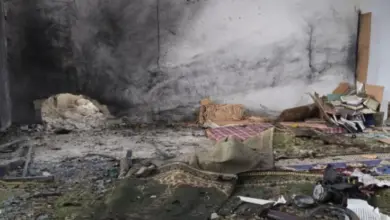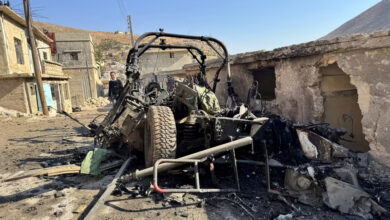
BEIRUT (AP) — For Syria’s Kurds, the United States’ abrupt pull-back from positions in northeast Syria carries a sharp sting, reviving the community’s memories over being abandoned in the past by the Americans and other international allies on whose support they had pinned their aspirations.
The Kurdish-led forces have been the U.S.′ partner in fighting the Islamic State group for nearly four years. Now the pull-back exposes them to a threatened attack by their nemesis, Turkey.
Turkey wants to carve out a zone of control across northern Syria along its border, a strip that would run through part of the heartland of the Kurdish minority where they have carved out a degree of self-rule amid Syria’s civil war.
Over the past century, Kurds have gotten close to setting up their own state or autonomous regions on, only to have their dreams shattered after being abandoned by world powers. An old Kurdish proverb reflects a history of disappointments: “We have no friends but the mountains.”
Here’s a look at that past:
___
WHO ARE THE KURDS?
The Kurds are an ethnic group numbering some 20 million people spread across four nations — 10 million in Turkey, 6 million in Iran, 3.5 million in Iraq, and a little over 2 million in Syria. They speak an Indo-European language, related to Iran’s Farsi, and are overwhelmingly Sunni Muslim.
The 191,000-square-kilometer (74,000-square-mile) Kurdish area arcs through a mountainous zone from southeast Turkey to northwest Iran. They’re divided not only by borders but by tribal, political and factional splits that the regional powers have often used to manipulate them.
___
HISTORY OF STRUGGLE AND BETRAYALS
With the Ottoman Empire’s collapse after World War I, the Kurds were promised an independent homeland in the 1920 Treaty of Sevres. But the treaty was never ratified, and “Kurdistan” was carved up. Since then, there have been almost continuous Kurdish rebellions in Iran, Iraq and Turkey.
Two events have been burned in the Kurds’ memories as betrayals by Washington.
In 1972, the U.S. helped arm an Iraqi Kurdish insurrection against Baghdad. It did so on behalf of Iran, then led by America’s ally, Shah Mohammad Reza Pahlavi, who hoped to pressure the Iraqi government in an ongoing border dispute. Three years later, the shah signed a border agreement with Baghdad and shut off the weapons pipeline. Then-Kurdish leader Mustafa Barzani pleaded to U.S. Secretary of State Henry Kissinger for support, but the American help ended. The Iraqi government crushed the Kurdish rebellion.
Iraq’s Kurds rose up again in the 1980s with Iranian backing during the Iran-Iraq war. Iraqi leader Saddam Hussein’s army waged a brutal scorched-earth campaign, using poison gas and forcibly resettling up to 100,000 Kurds in the southern desert.
The second event came in 1991, after the U.S.-led Gulf War that liberated Kuwait from Iraqi forces. Then-President George H. W. Bush called on Iraqis to rise up against Saddam. The Kurds in the north and Shiites in the south revolted, and Saddam responded with a brutal crackdown. While Bush had not explicitly promised support, Kurds and Shiites felt left in the lurch.
Still, a U.S.-enforced no-fly zone over northern Iraq helped ensure a degree of Kurdish autonomy. After Saddam’s fall in 2003, Washington ensured Iraq’s new constitution enshrined that autonomous zone. But the U.S. has drawn the line against Kurdish independence.
___
IN SYRIA, EVERYTHING TO LOSE?
Syria’s Kurds have hoped for full autonomy in the northeast corner of the country where their population is concentrated. Damascus has not allowed it, and Turkey is vehemently opposed to it.
Still, they gained a degree of autonomy unthinkable before the war, including teaching their own language at schools, setting up their own police force and controlling an administrative council that runs day to day affairs.
The U.S. found in the Kurds an effective partner on the ground to fight the Islamic State group. Armed by the U.S. and backed by American troops and firepower, the Kurdish-led forces finally put an end to IS’s territorial hold — at the cost of thousands of Kurds killed in years of fighting. The force now control nearly a third of Syria.
The Kurds had hoped the alliance would give weight to their autonomy ambitions.
But the alliance raised friction between the U.S. and Turkey. Ankara views the main Syrian Kurdish militia, which is linked to Kurdish insurgents in Turkey, as a terrorist group.
Turkey sent troops into Syria in August 2016 and seized an area along the western end of the border. It later overran the key enclave of Afrin, leading to the displacement of tens of thousands of Kurds.
Kurds now fear the same will happen on a larger scale if Turkey seizes the rest of the zone it seeks — extending all the way east to the Iraqi border and as far as 30 to 40 kilometers deep (19 to 25 miles) into Syria.
By BASSEM MROUE
FILE — In this Oct. 17, 2016 file photo, a Kurdish Peshmerga convoy drives towards a frontline in Khazer, about 30 kilometers (19 miles) east of Mosul, Iraq. Syria’s Kurds have been America’s partner in fighting the Islamic State group for nearly four years. Now they are furious over an abrupt U.S. troop pull-back that exposes them to a threatened attack by their nemesis, Turkey. The surprise U.S. pull-back from positions near the Turkish border, which began Monday, Oct. 7, 2019, stung even more because the Kurds have been abandoned before by the United States and other international allies on whose support they’d pinned their aspirations. (AP Photo/Bram Janssen, File)




